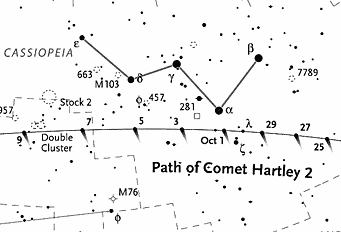103P/Hartley 2 is the somewhat prosaic name for a pretty nice comet in our skies right now. It’s still a little bit too faint to see without aid of binoculars or a telescope, but it’s getting brighter: on October 20th it’ll pass by the Earth at a distance of a mere 18 million km (11 million miles)!
Astronomers all over the planet are jumping at a chance to see a comet up close… and the views they’re getting are really, really cool. Behold!
That’s Hartley 2 as seen by WISE, an orbiting NASA mission designed to survey the sky in the infrared, so it’s very sensitive to objects that astronomers consider warm – that is, a few degrees above absolute zero! It’s seen comets before, since they fit the warm-to-astronomers-but-freezing-to-anyone-else category.
Mind you, the actual solid part of the comet is only a few kilometers across, far smaller than a single pixel in this picture. But it’s loaded with frozen ices which turn into gas as the comet nears the Sun, enshrouding the nucleus with fuzz, and streaming behind it as that long, long tail. In this picture, the tail is nearly 2 million kilometers in extent – well over a million miles!
 What I think is funny is what sometimes happens when you try to zoom in on the head of the comet: you get a fuzzy picture like this one. It’s hard to see detail in a comet, and sometimes when you use more magnification this is all you get. It may surprise you to find out this is a photo from the Hubble Space Telescope!
What I think is funny is what sometimes happens when you try to zoom in on the head of the comet: you get a fuzzy picture like this one. It’s hard to see detail in a comet, and sometimes when you use more magnification this is all you get. It may surprise you to find out this is a photo from the Hubble Space Telescope!
Even though it looks blurry, this is actually a very important picture. In a few weeks, the NASA mission EPOXI – what used to be called Deep Impact, but has now been re-purposed to look at planets around other stars and objects in our own solar system – will be passing near the comet, and images like this will help astronomers get a better understanding of how the comet is behaving (as well as more accurate positions for the comet over time). Also, this image does allow astronomers to estimate the size of the comet’s solid nucleus: it’s about 1.5 km (0.9 miles) across. That’s fair-to-middlin’ as these things go.
Also, sometimes comets emit jets of gas from frozen pockets on their surface. This can spin the comet up, and also sculpt amazing spiral patterns… and create hazards for any passing spacecraft. Hubble’s image doesn’t show any jets here, but had they been there they’d have been spotted. The fact that the comet looks relatively featureless is actually a good thing!
This all reminds me of a time in grad school when a bright comet was well-positioned to see from where I was. I remember looking at it through binoculars and it was spectacular! I was excited to look through a big telescope, figuring it would be a jaw-dropping view. But when I got to the eyepiece, it looked like I was examining a Q-tip with a magnifying glass. Sometimes, the long view is prettier.
 With Hartley 2, you can get your own chance to see it! It’s currently high in the northern sky just south of the constellation of Cassiopeia, which is easy to spot as a giant W in the northeast once the sky gets dark after sunset. Hartley 2 is still faint, and there are lots of things to see in that region of sky, so it’ll be a bit tough if you’re not familiar with the area. Helpfully, Sky and Telescope magazine has a great finder chart online. They also have descriptions of it and where it’ll be for the next few weeks. But right now the Moon is new, and so the skies will be darker: so if you have binoculars and a dark site, now is the time to look.
With Hartley 2, you can get your own chance to see it! It’s currently high in the northern sky just south of the constellation of Cassiopeia, which is easy to spot as a giant W in the northeast once the sky gets dark after sunset. Hartley 2 is still faint, and there are lots of things to see in that region of sky, so it’ll be a bit tough if you’re not familiar with the area. Helpfully, Sky and Telescope magazine has a great finder chart online. They also have descriptions of it and where it’ll be for the next few weeks. But right now the Moon is new, and so the skies will be darker: so if you have binoculars and a dark site, now is the time to look.
And if you can’t find it, that’s OK: stay outside, and scan the heavens with your binoculars. Jupiter is up, for example, and there’s so much to see! A night spent under the stars is never wasted.
Image credits: NASA/JPL-Caltech/UCLA, NASA, ESA, H. Weaver (The Johns Hopkins University/Applied Physics Lab), Sky and Telescope